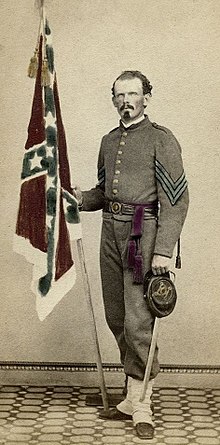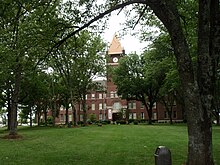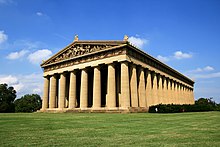William Crawford Smith | |
|---|---|
 | |
| Born | November 26, 1837 Petersburg, Virginia, U.S. |
| Died | February 5, 1899 (aged 61) Manila, Philippines |
| Resting place | Mount Olivet Cemetery |
| Occupation | Architect |
| Military career | |
| Allegiance | |
| Service/ | Confederate States Army United States Army |
| Years of service | 1861–1865 (CSA) 1898–1899 (USA) |
| Rank | |
| Battles/wars | American Civil War Philippine–American War |
William Crawford Smith (November 26, 1837 – February 5, 1899) was an American architect who served in the Confederate States Army during the American Civil War and in the United States Army during the Philippine–American War. He designed many buildings in Nashville, Tennessee, including Kirkland Hall, the first building on the campus of Vanderbilt University, and the Parthenon in Centennial Park.


Early life[edit]
William Crawford Smith was born on November 26, 1837, in Petersburg, Virginia.[1][2] He moved to Nashville, Tennessee in the 1850s.[2]
During the American Civil War of 1861–1865, he returned to Virginia, joined the Confederate States Army and served as a sergeant and ensign in the 12th Virginia Infantry.[1][3] He fought in the First Battle of Bull Run, the Battle of Richmond, the Second Battle of Bull Run, and the Battle of Gettysburg.[2] He was wounded twice in the war effort.[2]

Career[edit]
After the war, Smith was an architect in Nashville, Tennessee.[1] In 1874, he designed the Main Building of Vanderbilt University, later known as Kirkland Hall, as two French Gothic towers.[4][5] The building burnt down in a fire in 1905, and it was later rebuilt with only one tower.[5]
Smith designed the Collier-Crichlow House in Murfreesboro, Tennessee in 1880 for Ingram Banks Collier III, who served as the mayor of Murfreesboro from 1872 to 1873.[6] It was listed on the National Register of Historic Places on July 16, 1973.[7]
Smith was commissioned to design the Masonic Temple in Columbia, Tennessee in 1883.[8] A decade later, in 1893, Smith designed the Colemere Mansion in Nashville for Confederate Colonel Edmund William Cole, who served as the President of the Nashville, Chattanooga and St. Louis Railway after the war. The house burnt down in October 1929.[9] Meanwhile, Smith designed Memorial Hall on the campus of Cumberland University in Lebanon, Tennessee, built from 1892 to 1896.[10]
Additionally, Smith was commissioned to two buildings in Downtown Nashville in 1893: a four-storey building on the corner of Printer's Alley and Church Street and a five-story building at 317 North College Street.[11] He was also commissioned to restore a three-story building at 315 North College Street.[11]
Meanwhile, in 1897, Smith designed The Parthenon in Centennial Park.[12][13]
Smith quit his architectural career to serve in the Philippine–American War, where he commanded the 1st Tennessee Infantry Regiment of the United States Army in 1898–1899.[14]
Personal life[edit]
Smith was married.[2] They had several children, including a son, George J. Smith, who also served in the Philippine–American War,[15] and a daughter, who married Hart B. Blanton.[2]
Smith was a Knight Templar.[16]
Death and legacy[edit]
Smith died of heat exhaustion during the Battle of Manila February 5, 1899, in the Philippines.[1][14][17] His corpse was shipped back to San Francisco, California, where it received a Masonic service.[18] Shortly after, his corpse was returned to Nashville, where it lay in the Nashville Masonic Temple, followed by a service in the Tabernacle.[18] He was buried on April 19, 1899, at the Mount Olivet Cemetery.[2][19]
In 1903, an honorary plaque from the Nashville Red Cross Society was installed inside the Parthenon.[2] The ceremony was attended by Benton McMillin, who served as the governor of Tennessee from 1899 to 1903.[2]
The Parthenon has been listed on the National Register of Historic Places in Davidson County since February 23, 1972. Memorial Hall has been listed on the National Register of Historic Places in Wilson County since April 29, 1977.[20] Meanwhile, one of Smith's apprentices, Clarence Kelley Colley, went on to become a renowned architect in his own right, with buildings listed on the National Register of Historic Places.[21]
References[edit]
- ^ a b c d "Regimental Roster First Tennessee. The American Will Present One Complimentary Copy To Each Applicant At The Business Office". The Nashville American. Nashville, Tennessee. April 8, 1899. p. 2. Retrieved November 22, 2015 – via Newspapers.com.

- ^ a b c d e f g h i "Valor's Reward Paid His Memory. Tablet Unveiled to the Memory of Col. C. W. Smith. On Walls of the Parthenon. Rare Tribute Paid the Name of Soldier-Architect. Tully Brown and Lieut. Caruthers Deliver Addresses of Occasion Before Several Hundred People, Among Whom Were Comrades of Two Wars". The Nashville American. Nashville, Tennessee. July 6, 1903. pp. 5, 7. Retrieved November 22, 2015 – via Newspapers.com.

- ^ Henderson, William D. (1984). 12th Virginia Infantry, The Virginia Regimental History Series. Petersburg, VA: H. E. Howard Inc.
- ^ "The Vanderbilt. Laying of the Corner Stone of the Great University Yesterday. Interesting Ceremonies and a Large Attendance. Addressed by Bishops McTyeire and Wrightman, Gov. Brown and Chancellor Morgan". Nashville Union and American. Nashville, Tennessee. April 29, 1874. p. 8. Retrieved November 22, 2015 – via Newspapers.com.

- ^ a b Hoobler, James A. (2008). A Guide to Historic Nashville, Tennessee. Charleston, South Carolina: The History Press. p. 145. ISBN 9781596294042.
- ^ Harber, Susan (March 18, 2017). "Collier-Crichlow-Smythe House's beauty shines through years". Rutherford County Tennessee Historical Society. Retrieved December 13, 2017.
- ^ "Collier-Crichlow House". National Park Service. United States Department of the Interior. Retrieved December 13, 2017.
- ^ "Columbia. The Contractors Pushing the Work on the Masonic Temple". The Daily American. Nashville, Tennessee. August 1, 1883. p. 3. Retrieved November 22, 2015 – via Newspapers.com.

- ^ Zepp, George (2009). Hidden History of Nashville. Charleston, South Carolina: The History Press. p. 71. ISBN 9781625843067.
- ^ Van West, Carroll (1995). Tennessee's Historic Landscapes: A Traveler's Guide. Knoxville, Tennessee: University of Tennessee Press. p. 309. ISBN 9780870498817.
- ^ a b "Building Improvements. Important Work Under Contract and Agree On". The Nashville American. Nashville, Tennessee. April 26, 1893. p. 4. Retrieved November 22, 2015 – via Newspapers.com.

- ^ Coleman, Christopher K. (Fall 1990). "From Monument to Museum: The Role of the Parthenon in the Culture of the New South". Tennessee Historical Quarterly. 49 (3): 140. JSTOR 42626877.
- ^ "Counting Up The Cost. Executive Committee Considers Plans For Buildings. Several Architects Explain Their Pictures and Discuss Possible Changes, Cost of the Buildings and Other Matters of Interest – Hearing to be Resumed To-Day". The Nashville American. Nashville, Tennessee. November 19, 1895. p. 5. Retrieved November 23, 2015 – via Newspapers.com.

- ^ a b Baxter, Colin F. "Spanish–American War". The Tennessee Encyclopedia of History and Culture. Tennessee Historical Society & University of Tennessee Press. Retrieved November 23, 2015.
- ^ "Honorably Discharged. George J. Smith, Son of the Late Col. W. C. Smith, Relieved from Duty". The Nashville American. Nashville, Tennessee. April 23, 1899. p. 9. Retrieved November 22, 2015 – via Newspapers.com.

- ^ "Knights Templar". The Nashville American. Nashville, Tennessee. May 15, 1896. p. 5. Retrieved November 22, 2015 – via Newspapers.com.

- ^ "Honor The Dead". The Nashville American. Nashville, Tennessee. February 10, 1899. p. 4. Retrieved November 23, 2015 – via Newspapers.com.

- ^ a b "Loving Tribute To His Memory. Col. W. C. Smith's Body In State At The Masonic Temple. Hundreds Visit The Hall. Soldiers Who Enlisted In His Command Trend The Silent Watch – Flag Draped About The Casket – Funeral Arrangement". The Nashville American. Nashville, Tennessee. April 18, 1899. p. 3. Retrieved November 23, 2015 – via Newspapers.com.

- ^ "Col. Smith's Funeral. Time Fixed For April 10 – Meeting of the Committee Yesterday". The Nashville American. Nashville, Tennessee. April 11, 1899. p. 5. Retrieved November 23, 2015 – via Newspapers.com.

- ^ "Memorial Hall, Cumberland University". National Park Service. Retrieved November 23, 2015.
- ^ Adgent, Nancy L. "Clarence Kelley Colley (1868–1956)". The Tennessee Encyclopedia of History and Culture. Tennessee Historical Society & University of Tennessee Press. Retrieved November 23, 2015.